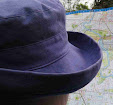 |
| Paris, France September 1918. Soldiers from Australia, New Zealand and South
Africa with Ettie Rout of the New Zealand Volunteer Service relaxing on
leave during a card game. AWM H03654. |
Ettie Rout was born in Australia and later moved to New Zealand with her family. She was a reformer with strong convictions about the health of the British Race, but unlike many of her contemporaries, did not believe that moral purity was a strong enough tool to use in the fight against the epidemic of venereal disease that beset the army during the war. Ettie believed in preventative measures, or at least cleansing after the act, and also encouraged the troops to visit regulated establishments.
Ettie raised the ire of many in the British, New Zealand and Australian communities, and after the war their outrage led them to continue the fight against Ettie, as shown in this file at the National Archives of Australia relating to
Ettie Rout - Question of Admission to Australia in 1920.
The file amply illustrates the ambivalence at higher levels about controlling VD in the troops, on the one hand Surgeon-General Sir Neville Howse, VC, KCB accused Ettie Rout as peddling "pernicious propaganda", and he considered her "mentally unhinged". On the other hand, the Department of Home and Territories handled Howse's complaints, and that of others, with the simple expedient of "no action".
Atlee Hunt, the Department Secretary, wrote to Howse saying that "The Minister has decided to take no action in the way of preventing her from landing. Thanking you for favouring us with your views on this case".
The General Secretary of the YMCA, Percival J L Kenny also wrote to the Department to attempt to stop a visit by Ettie Rout - representing himself as "one of the thousands engaged in trying to uplift manhood and boyhood". He claimed that ..."Miss Rout's actions in France not only made "Sexual intercourse" on the part of the troops easy, but strongly encouraged it by suggesting it to the men as soon as they arrived in Paris on leave". (p 8)
The Women's Reform League of NSW was likewise enraged at the thought of Ettie visiting Australia. But despite the nasty letter-writing campaign no reason was found to stop her visit.
Mark Harrison, in his detailed article about
The British Army and the Problem of Venereal in France and Egypt during the First World War mentioned that many of the purity campaigners with the army - the Chaplains for example - were also not immune to the temptations of the flesh - much to the amusement of the men when they ended up in the same hospitals for treatment.
Shaming was one of the forms of punishment used, though Officers were less likely to have VD noted on their record of service - but if they were in a hospital at Bulford in England, that may well have been the cause.
Ettie continued her campaign against venereal disease, and letters from her appeared in Australian newspapers towards the end of 1920:
PREVENTION OF VENEREAL DISEASE. (1920, December 17).
The Register (Adelaide, SA : 1901 - 1929), p. 8.
It was possible to cure VD in this period before penicillin, but it was a long process, and troops could be hospitalised from 30 to 50 days while going through the cure. This was not a good outcome for Army officials, but they were divided about how to handle the problem - moral purity as opposed to a more pragmatic approach to prevention.
In 1906, August Paul von Wassermann, a German bacteriologist developed a complement fixation serum antibody
test for syphilis – the “Wasserman reaction”. This test is mentioned in many B2455 records.
Also in 1906 Paul Ehrlich, a German histological chemist, began experimenting with
arsenic compounds in treating syphilis in rabbits. "His experiments were
not very successful as most of the earlier arsenicals he experimented
with were too toxic, but in 1909 he and his assistant Sahachiro Hata, a
Japanese bacteriologist, finally found success with the compound
dioxy-diamino-arsenobenzol-dihydrochloride which they called drug
“606”. This led in 1910 to the manufacture of arsphenamine, which subsequently became known as
Salvarsan, or the
“magic bullet”, and later in 1912, neoarsphenamine, Neo-salvarsan, or drug
“914”.
In 1908 Ehrlich was awarded the Nobel Prize for his discovery". (see
Syphilis – Its early history and Treatment until Penicillin and the Debate on its Origins )
Further useful links on this subject are from
The Encyclopaedia of New Zealand and from the
Australian Light Horse Association forum.
UPDATED







.JPG)















































